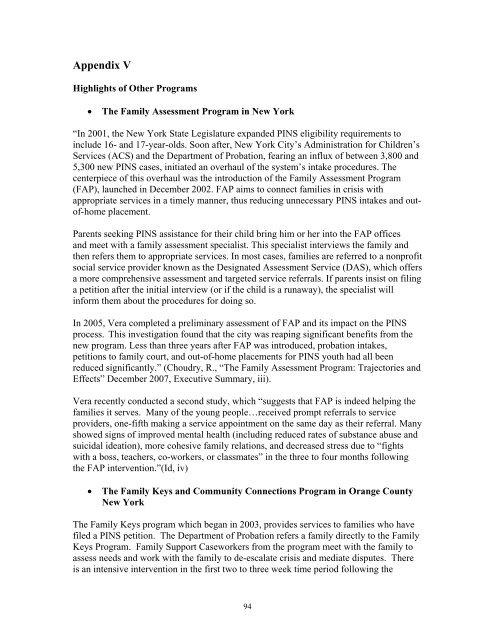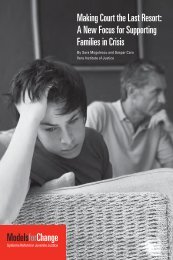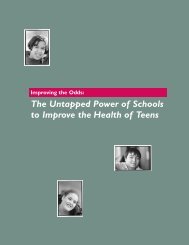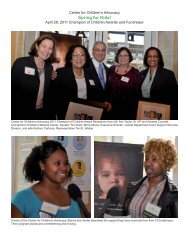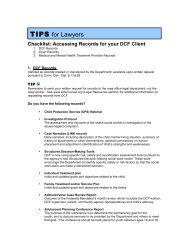FWSN-advisorybd-repo.. - The Connecticut Juvenile Justice Alliance
FWSN-advisorybd-repo.. - The Connecticut Juvenile Justice Alliance
FWSN-advisorybd-repo.. - The Connecticut Juvenile Justice Alliance
Create successful ePaper yourself
Turn your PDF publications into a flip-book with our unique Google optimized e-Paper software.
Appendix V<br />
Highlights of Other Programs<br />
• <strong>The</strong> Family Assessment Program in New York<br />
“In 2001, the New York State Legislature expanded PINS eligibility requirements to<br />
include 16- and 17-year-olds. Soon after, New York City’s Administration for Children’s<br />
Services (ACS) and the Department of Probation, fearing an influx of between 3,800 and<br />
5,300 new PINS cases, initiated an overhaul of the system’s intake procedures. <strong>The</strong><br />
centerpiece of this overhaul was the introduction of the Family Assessment Program<br />
(FAP), launched in December 2002. FAP aims to connect families in crisis with<br />
appropriate services in a timely manner, thus reducing unnecessary PINS intakes and outof-home<br />
placement.<br />
Parents seeking PINS assistance for their child bring him or her into the FAP offices<br />
and meet with a family assessment specialist. This specialist interviews the family and<br />
then refers them to appropriate services. In most cases, families are referred to a nonprofit<br />
social service provider known as the Designated Assessment Service (DAS), which offers<br />
a more comprehensive assessment and targeted service referrals. If parents insist on filing<br />
a petition after the initial interview (or if the child is a runaway), the specialist will<br />
inform them about the procedures for doing so.<br />
In 2005, Vera completed a preliminary assessment of FAP and its impact on the PINS<br />
process. This investigation found that the city was reaping significant benefits from the<br />
new program. Less than three years after FAP was introduced, probation intakes,<br />
petitions to family court, and out-of-home placements for PINS youth had all been<br />
reduced significantly.” (Choudry, R., “<strong>The</strong> Family Assessment Program: Trajectories and<br />
Effects” December 2007, Executive Summary, iii).<br />
Vera recently conducted a second study, which “suggests that FAP is indeed helping the<br />
families it serves. Many of the young people…received prompt referrals to service<br />
providers, one-fifth making a service appointment on the same day as their referral. Many<br />
showed signs of improved mental health (including reduced rates of substance abuse and<br />
suicidal ideation), more cohesive family relations, and decreased stress due to “fights<br />
with a boss, teachers, co-workers, or classmates” in the three to four months following<br />
the FAP intervention.”(Id, iv)<br />
• <strong>The</strong> Family Keys and Community Connections Program in Orange County<br />
New York<br />
<strong>The</strong> Family Keys program which began in 2003, provides services to families who have<br />
filed a PINS petition. <strong>The</strong> Department of Probation refers a family directly to the Family<br />
Keys Program. Family Support Caseworkers from the program meet with the family to<br />
assess needs and work with the family to de-escalate crisis and mediate disputes. <strong>The</strong>re<br />
is an intensive intervention in the first two to three week time period following the<br />
94


